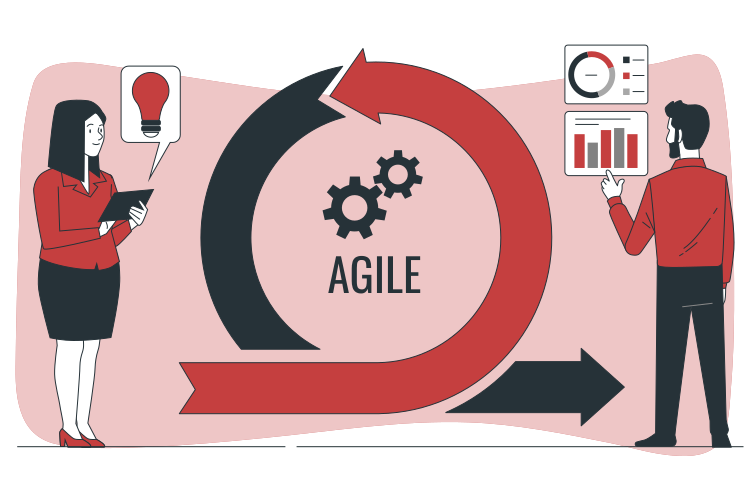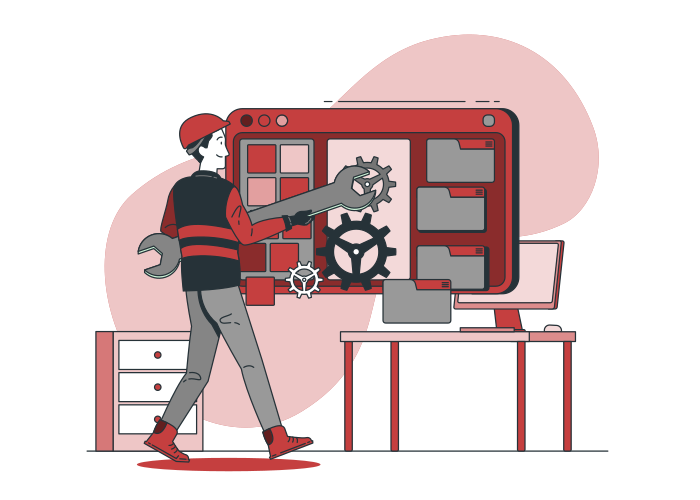Are you looking for ways to boost your workforce’s productivity and overall performance? In today's fast-paced work environment, staying adaptable is crucial for success. Therefore, implementing agile practices can be a game-changer. In fact, agile methodology has several benefits for your employees. It allows your team to respond quickly to changes. They can stay focused on delivering high-quality results.
Hence, by adopting this flexible approach, you can create a work environment that fosters collaboration, innovation, and continuous improvement. Thus, this will ultimately lead to enhanced employee performance.
In this blog we will discuss the top 5 benefits of agile methodology for your workforce to enhance employee performance.
Understanding Agile Methodology Benefits for Employees
Agile teams rely on data to make smart choices, thereby leading to better performance. In fact, organizations that underwent highly successful agile transformations reported approximately 30% improvements in efficiency, customer satisfaction, employee engagement, and operational performance, according to McKinsey's research. With Agile methodology, you can track and boost team performance using various metrics while ensuring continuous improvement. At Utkrisht, we specialize in providing top-tier remote IT and digital talent, enabling organizations to seamlessly integrate Agile practices and achieve measurable productivity gains.
However, to boost employee performance with Agile methodology, it is best to understand it first. Agile is a flexible way to manage work. It indeed values teamwork, constant improvement, and being adaptable.
What is Agile Methodology?
Agile methodology started in software development but now helps many industries. It breaks work into small parts. Then, it delivers value in short periods.
Evolution from Traditional Management Approaches
Agile is different from old ways of managing. It's flexible and changes easily. Therefore, this lets teams quickly meet customer needs and adapt to new trends.
Overview of Employee-Centric Advantages
Agile brings many benefits to employees. It gives them more freedom, better teamwork, and chances to learn and grow. These advantages improve employee satisfaction and hence make them better at their jobs.
1. Enhanced Collaboration and Team Dynamics
Agile makes teams work better together. It helps teams to be more productive and satisfied at work.
Breaking Down Silos Between Teams
Agile gets rid of team silos. It makes teams work together from different areas. Hence, everyone works towards the same goals.
- Cross-functional teams understand project goals better.
- Team members build trust and communicate better through regular talks.
Daily Stand-ups and Their Impact on Communication
Daily stand-up meetings are key in Agile. Thus, enabling team members to share their updates and challenges. This helps in:
- Keeping team efforts on track with project goals.
- Quickly solving problems.
- Creating a culture of openness and responsibility.
Improved Team Cohesion Through Agile
Top software companies, implementing agile methodology, saw big changes with Agile. They started daily stand-ups and sprint reviews. This made the team work better together and feel more united. In fact, they were more motivated and delivered better work.
2. Increased Transparency and Accountability
Adopting Agile methodology brings more transparency and accountability to your team. Agile encourages open communication and clear roles. Moreover, it also makes project progress visible. Hence, this ensures your team works efficiently and effectively.
Visibility into Project Progress
This methodology offers many tools and practices for seeing project progress. Daily stand-ups, sprint planning, and retrospectives keep everyone informed. Thus, this transparency helps teams spot and fix problems early.

Clear Role Definition and Responsibilities
In such methodology, roles and responsibilities are clear. Team members know their tasks and are accountable. Therefore, this clarity prevents confusion and overlapping work, thereby making projects run smoother.
How Transparency Drives Performance Improvement
Transparency is crucial for improving performance in Agile teams. When team members know the project's status and challenges, they can adjust their work. Consequently, this leads to better teamwork, fewer mistakes, and hence, higher performance overall.
3. Adaptability and Continuous Learning
Adopting Agile practices helps create a culture of continuous improvement and adaptability. In this way, your workforce can quickly adapt to changes. Moreover, they see these changes as opportunities and not obstacles.
Embracing Change as a Constant
Agile methodology teaches that change is always coming and should be welcomed. Your teams become more flexible and ready to handle changes in projects. This adaptability is crucial in today's fast world.
Sprint Retrospectives as Learning Opportunities
Sprint retrospectives are a big part of this methodology. They let teams look back and see how to get better. Regular retrospectives help build a culture of always learning and improving.
Building Resilient Teams Through Iteration
Agile's iterative nature helps teams keep getting better with each try. Through each cycle, your team grows stronger. They learn from both wins and losses; as a result, they become more united and skilled.
Therefore, by embracing adaptability and continuous learning, you boost your workforce’s performance. Moreover, you also prepare your organization for success in a changing business world.
4. Employee Empowerment and Autonomy
Agile helps create a workplace where employees feel empowered and free. This approach, therefore, boosts motivation and productivity. Moreover, it also makes employees happier and perform better overall.
Self-Organizing Teams and Decision-Making Authority
Agile teams are self-organizing, with members making their own decisions. This freedom lets teams adapt fast to new situations. Moreover, it builds a sense of pride and responsibility.
Ownership of Work and Its Effect on Motivation
When employees own their work, they're more motivated. They feel responsible for the project's success. Hence, this leads to better work and a sense of accomplishment.
Balancing Freedom with Accountability
Autonomy is key, but so is accountability. Agile balances these two. It lets teams make decisions while keeping them responsible for their work.

5. Measurable Performance Improvements
Agile teams rely on data to make smart choices, and this leads to better performance. With such methodology, you can track and boost team performance using various metrics. Eventually, organizations can always get better.
Key Performance Indicators in Agile Environments
In the agile workplace, KPIs are key factors to checking team and project success. Metrics like lead time, cycle time, and throughput are used. They show how fast teams deliver value and where they can get better.
Velocity and Productivity Metrics
Velocity and productivity metrics are crucial in such methodology. On one hand, velocity shows how much work a team does in a sprint, thereby helping predict future work. Productivity metrics, on the other hand, check how efficient a team is, thus showing where they can improve. Therefore, tracking these helps employees work better and faster.
Beyond Numbers: Quality and Value Delivery
Not only are metrics important, but also the quality and value of work are significant. Agile teams aim to deliver top-notch products that meet customer needs. Thus, by looking at both numbers and quality, teams ensure they're not just hitting targets but also adding real value.
Agile Methodology: Enhancing Employee Performance for Organizational Growth
Agile methodology brings many benefits for improving employee performance. It improves teamwork and makes things more open. Moreover, it also makes teams more adaptable and empowered, thus leading to better results. Therefore, using agile methodology helps teams work better together. They become more motivated and focused on adding value. Hence, this leads to better performance and success for businesses.
So, by using Agile in your management, you can help your teams reach their best. This approach drives growth and success over time.
Key Takeaways
- Discover how Agile practices can improve team collaboration and productivity.
- Learn how to create a flexible work environment that adapts to change.
- Understand the importance of continuous improvement in enhancing employee performance.
- Find out how Agile methodology can boost employee engagement and motivation.
- Explore the role of Agile in driving innovation and delivering high-quality results.
FAQs
What are the primary benefits of implementing Agile methodology in the workplace?
Agile brings many benefits. Firstly, it boosts teamwork and communication. Further, it also makes work more transparent and accountable. Teams learn and grow together, feeling more in control of their work. Thus, this approach leads to better performance and results.
How does Agile methodology improve workplace productivity?
Agile makes work better by encouraging teamwork and openness. It helps teams adapt quickly and deliver results efficiently. In this way, Agile makes work more productive and effective.
What role do daily stand-ups play in Agile teams?
Daily stand-ups are key for teamwork. They help team members talk and work together better. This practice ensures everyone knows the project's goals and how they're doing, which is important for workplace success.
How does Agile methodology support employee empowerment?
Agile methodology empowers employees by letting teams work on their own. It gives team members the freedom to make choices and own their projects. Hence, this boosts their motivation and satisfaction at work.
Can Agile methodology be applied to non-software development teams?
Yes, Agile works for many teams, not just software ones. It's flexible and can help teams in marketing, sales, and HR too. This methodology makes teams more productive and effective.
How do you measure performance in an Agile environment?
In Agile, you track performance with metrics like velocity and productivity. You also look at quality and value delivered. Therefore, this gives a clear picture of how well the team is doing and where they can improve.




